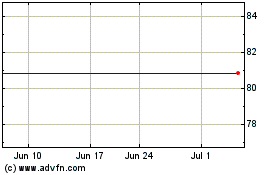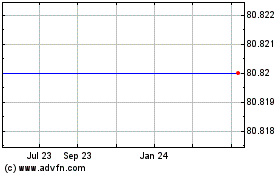Celebrating 30 Years of Innovation in Neuromodulation, St. Jude Medical Unveils Latest Product at American Academy of Pain Me...
February 03 2010 - 1:00PM
Business Wire
St. Jude Medical, Inc. (NYSE:STJ) today announced the U.S. Food
and Drug Administration (FDA) clearance of the Swift-Lock™ anchor,
a new product designed to help physicians efficiently secure
neurostimulation leads utilized in spinal cord stimulation (SCS)
therapy for the management of chronic pain. Introduced at the
American Academy of Pain Medicine (AAPM) annual meeting, the
Swift-Lock anchor builds on a 30-year history of developing
industry-leading neurostimulation products.
Designed to reduce anchoring time and enhance procedural
efficiency, the Swift-Lock anchor eliminates the need for sutures
or medical adhesive typically required to secure the anchor to the
lead. Featuring an easy-to-use mechanical lock, physicians secure
the anchor with a simple 90-degree twist. This design minimizes the
complexity and variability associated with anchoring leads.
“For more than 30 years we have focused on the development of
the most advanced line of clinically relevant neurostimulation
products to meet the needs of physicians and patients,” said Chris
Chavez, president of the St. Jude Medical Neuromodulation Division.
“The Swift-Lock anchor is yet another example of our commitment to
provide best-in-class solutions to aid in the management of chronic
pain.”
The Swift-Lock anchor features include:
- Intuitive locking mechanism that
provides tactile and visual confirmation that the lead is
locked
- Strong fixation to the lead to
help mitigate the risk of migration
- Highly radiopaque material to
provide easy fluoroscopic visualization
- Simple twist lock mechanism
allows for easy repositioning of the lead if needed
Three decades of leading edge neurostimulation
technologyFor more than 30 years, the St. Jude Medical
Neuromodulation Division has developed new technologies to treat
chronic pain and other neurological disorders. Today more than
60,000 patients in 35 countries have been implanted with St. Jude
Medical neurostimulation systems.
Some of the innovative products that St. Jude Medical was first
to bring to market include:
- World’s smallest neurostimulator
for chronic pain – the Eon Mini™ spinal cord stimulator
- First-of-its-kind five-column
paddle lead -- the Penta™ lead
- Next-generation programming
platform used to optimize neurostimulation therapy --
MultiSteering™ Technology software for Rapid Programmer™
- First spinal cord stimulator
with constant current circuitry – the Genesis™ neurostimulator
- World’s smallest,
longest-lasting rechargeable deep brain stimulation (DBS) device
for treating the symptoms of Parkinson’s disease -- the Brio™
neurostimulator (CE Mark approval)
Focused on research, St. Jude Medical is developing new
technologies to address a growing list of neurological disorders.
Clinical studies are currently underway for Parkinson’s disease,
essential tremor, migraine headaches, major depressive disorder,
and others.
Spinal cord stimulators are implanted neurostimulation devices
that send mild electrical pulses from an implanted device to leads
that are placed in the epidural space. These low intensity pulses
interrupt the pain signals’ pathways to the brain by stimulating
selective nerve fibers along the spinal cord. More information can
be obtained about neurostimulation therapy at
www.PowerOverYourPain.com.
Chronic pain affects millions of patients worldwide. In the
U.S., more than 76.5 million people are categorized as suffering
from chronic pain by the American Pain Foundation. Estimates by the
National Institutes of Health place the costs for lost work time
and healthcare expenses at approximately $100 billion every
year.
About St. Jude Medical
St. Jude Medical develops medical technology and services that
focus on putting more control into the hands of those who treat
cardiac, neurological and chronic pain patients worldwide. The
company is dedicated to advancing the practice of medicine by
reducing risk wherever possible and contributing to successful
outcomes for every patient. Headquartered in St. Paul, Minn., St.
Jude Medical employs more than 14,000 people worldwide and has four
major focus areas that include: cardiac rhythm management, atrial
fibrillation, cardiovascular and neuromodulation. For more
information, please visit sjm.com.
Forward-Looking Statements
This news release contains forward-looking statements within the
meaning of the Private Securities Litigation Reform Act of 1995
that involve risks and uncertainties. Such forward-looking
statements include the expectations, plans and prospects for the
Company, including potential clinical successes, anticipated
regulatory approvals and future product launches, and projected
revenues, margins, earnings and market shares. The statements made
by the Company are based upon management’s current expectations and
are subject to certain risks and uncertainties that could cause
actual results to differ materially from those described in the
forward-looking statements. These risks and uncertainties include
market conditions and other factors beyond the Company’s control
and the risk factors and other cautionary statements described in
the Company’s filings with the SEC, including those described in
the Risk Factors and Cautionary Statements sections of the
Company’s Quarterly Reports on Form 10-Q for the fiscal quarters
ended April 4, 2009, July 4, 2009 and October 3, 2009. The Company
does not intend to update these statements and undertakes no duty
to any person to provide any such update under any
circumstance.
SJM (NYSE:STJ)
Historical Stock Chart
From Oct 2024 to Nov 2024

SJM (NYSE:STJ)
Historical Stock Chart
From Nov 2023 to Nov 2024
